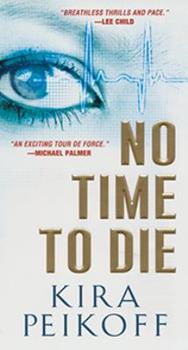No Time to Die
- By Kira Peikoff
- Pinnacle Books
- 448 pp.
- Reviewed by Philip K. Jason
- September 29, 2014
A sharp biomedical thriller asks, what if old age and infirmity were not inevitable?

What if the aging process could be slowed or stopped? What if human beings could reach their optimal physical state and then just stay there, even as they continued to learn, to explore, to love, and to create? Some might say that such a scientific breakthrough would soon lead to an overcrowded globe and exhaustion of resources. Others might worry that those with the keys to this kingdom would exploit their power. Who would be the gatekeepers? These and other related questions drive Kira Peikoff’s delightfully brainy and thrillingly suspenseful novel No Time to Die, in which this “what if” becomes the reality of her fictional world.
Peikoff launches her story not with airy generalizations but with attention-grabbing, violent, and mysterious actions. We enter a Washington, D.C., lab in which a proud scientist is working with chimpanzees. His company tests experimental medications on these animals in the process of bringing the drugs to market for human consumption. An intruder posing as a company board member arranges for the chimps to attack the scientist. He leaves a calling card bearing the name Galileo.
At New York’s Columbia University, a researcher pushes ahead with unauthorized experiments. Forced into retirement, she is soon given a new opportunity to pursue her work. Who will she report to? A man calling himself Galileo.
The focal character of the book is Zoe Kincaid. Zoe will soon be 21 years old, but she looks 12. Maturing normally in other ways, she is not what she seems. Having attempted college, Zoe floundered when seen as a freak. Hormone therapies have failed to have any effect.
Now, with her frail grandfather’s support, she consults with Dr. Carlyle, “a legendary diagnostician in genetic disorders” and consultant to the Undiagnosed Diseases Program at the National Institutes of Health. He would seem to be her last chance. Zoe pays the $10,000 charge for the lab and imaging fees with her parents’ credit card—but without their permission. Dr. Carlyle makes the diagnosis that Zoe stopped aging at 14.
With this information, Zoe at least has a battle to fight, even though it means separating herself from her parents, who are quite unable to face the truth about their daughter’s condition or her much-needed independence.
When Les Mahler, head of the Justice Department’s Bioethics Committee, receives a copy of a mysterious Galileo postcard to mark the disappearance of the Columbia University researcher, Helen McNair, it is the 27th such postcard to come his way. Where are all these scientists, doctors, and patients? Where is the headquarters of the Network that has, in Mahler’s view, abducted them? How does Galileo keep a step ahead of Mahler’s investigation into the Network’s doings?
Here is Galileo’s mantra, as voiced to research professor Natalie Roy: “Our mission is to give experts like you the total freedom required to pursue biomedical advances as quickly and efficiently as possible. No board-required approvals, no drug companies or bureaucrats pushing agendas, no byzantine FDA regulations.”
Mahler is also a man with a mission, as well as a cruel streak. He wishes to bring stringent oversight to the regulation of human experimentation. He feels vulnerable people are being persuaded to take great risks for the sake of researchers’ egos and corrupt motives. However, his own ego is enormously dangerous (so dangerous that he lives at the top of a 30-story Georgetown high-rise, an impossibility given D.C.’s building height restriction ordinance).
The battle soon takes shape between Mahler’s FBI-supported committee and the Network, which readers learn is not made up of abductees but rather of volunteers. The search to understand the cause of Zoe’s abnormality begins at Columbia University’s Department of Biological Sciences, with Dr. Roy as the principal researcher. It’s her theory that is being tested, with the aim of duplicating Zoe’s condition in people who are fully mature, stopping the progression of aging at the peak time of physical capacity.
All along the way, Peikoff interlaces the action with a stream of scientific information and speculation presented with excited clarity. The characters love what they are doing and feed off each other’s dedication and intellectual daring. Mahler is dedicated to tracking them down and ending their underground lawlessness. Galileo, the Network’s leader, is pushed to the limit of his astounding abilities to help such programs succeed.
Within this compelling look at individuals and groups at work in the university- and government-based research community, Peikoff offers a frightening display of ambition, competition, and careerism gone wild.
The author builds suspense by masterful use of a commonplace technique: shifting points of view and leaving one person’s (or group’s) perspective while we are taken through other perspectives and then back again. This technique amplifies our anticipation and spreads it over several questions that are left hanging until we return to knit up the severed plot strands.
Peikoff also engages readers with her vivid yet economical handling of various settings, the most challenging being the secret retreat in New Mexico at which Galileo has developed a kind of fortress research facility complete with residences and support services for a small community.
No Time to Die has a large cast of sharply individualized major and minor characters, each given distinctive personalities, prejudices, and motives for their actions. However, it is the entertaining yet sophisticated exploration of the biggest ideas and issues shaping our future that distinguishes this tantalizing biomedical thriller.
Philip Jason is professor emeritus of English at the United States Naval Academy. A former editor of Poet Lore magazine, he is the author or editor of 20 books, including Acts and Shadows: The Vietnam War in American Literary Culture and Don’t Wave Goodbye: The Children’s Flight from Nazi Persecution to American Freedom. His reviews appear in a wide variety of regional and national publications.

